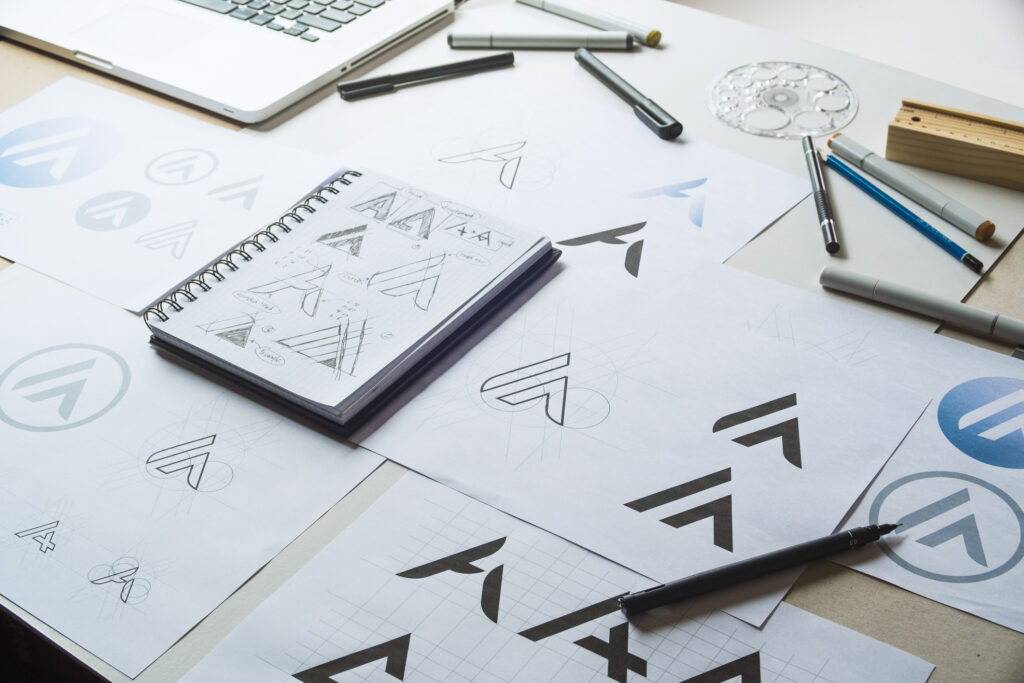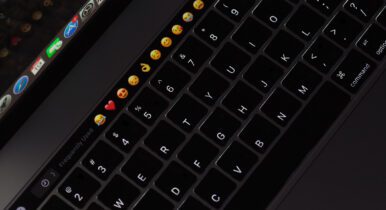The Year’s Best Political Graphic Design and Branding Advice
From balancing client feedback to common design mistakes to predictions for what’s next, here’s what some of the industry’s most creative minds told us in 2021.

Image Credit:Chaosamran_Studio
As the sheer volume of content produced by campaigns has exploded over the past two cycles, creative directors and graphic designers now fulfill increasingly critical roles in political organizations. Yet they’re often the professionals we hear from the least.
That’s the biggest reason C&E created its design and branding Q&A series this year (interviews are featured in every addition of our Creative Newsletter). What’s below is some of the best advice that came out of this interview series in 2021.
C&E: What are the dominant trends in political design at the moment?
Megan Magray, Co-Founder, Agitprop Collective: There are two ends of the spectrum. First, there’s old, classic political design. Then there’s this other end where we’re pushing the boundaries and we’re creating a brand for a candidate and it goes too far into trying to tie this start-up-y, digital-first Instagram style to a candidate. Maybe it appeals to a certain segment of voters, but I think it can be off-putting to people who aren’t used to seeing that.
I try to stick to my, sort of, central design values: We’re working towards something that is clean and optimistic and open and bright.
We’re working on this campaign together because we really, really believe in what we’re doing. The constant tension for 99 percent of grassroots campaigns is, ‘we want to fit all of this text on this mailer,’ and everything is happening in a chaotic way and very last minute. We’re trying to ensure our material is not only accessible, but culturally competent. There are a lot of things to balance but at the end of the day it’s really about using design to advance the communication of your candidate’s values, not as a way to define them.
C&E: How do you make design and branding personal for candidates?
Robert Arnow, Creative Director, Incitement Design: In my experience, the candidate exerts a lot of control. If they’re not open minded and they’re not creative, their personality will come through in the final product. Although we’d like them to take more of a back seat to it, and let us take more of a lead, they often feel like they need to be connected to the final product in some way.
We talk through it with them in an organic way, and try to get a sense of what the vibe of the candidate is. I want to find out what parts of the campaign they really want to emphasize. I want to understand their campaign strategy and help them crystalize that. Mostly people are trying to emphasize something, but sometimes they want to de-emphasize something. Like if they’re really young, they may want to de-emphasize that.
Most of the time, though, the idea is to really talk to the client to try to help them crystalize the most central feeling or vision or aspect of their campaign that can then be communicated into something visual.
C&E: Is there something holding political design back?
Deroy Peraza, Partner & Creative Director, Hyperakt: The way that the majority of candidates approach branding is fundamentally broken. I think they underestimate the importance of the work. They underestimate the importance of design, and how much access the designer needs to do that job justice. Generally, I would say that any designers, including ourselves, are under a ton of pressure to do something that feels moderately well executed and on point in two weeks. I see it as kind of miraculous to get close to the mark. It just warrants more time. It warrants more of an investment in doing the job well.
I’ve heard a lot of stories from colleagues who have worked with other campaigns and have had zero direct contact with the candidate — all information was second- or third-hand. It’s just very surface-level information to build a brand with. A lot is left to the design team to figure out. That’s often why you get kind of surface-level brands that are picking a font and picking a couple colors that feel right and the rest is sort of built on the fly. Brands are much more powerful when they have a real story that is authentic behind them.
C&E: What’s something campaigns can be doing better when developing their logo and branding package?
Amanda Biundo, Creative Director, Ascent Strategic: I see a lot of down-ballot races where they’ll have a campaign yard sign design and they’ll call that their logo. But logos are so much more complex — even the most simple ones — than a 24×16 yard sign. So you need to really adapt your logo into these spheres and think about what is happening in different spaces. Will your logo look good in all black? Will it look good in all white? If not, you might want to adjust some things. Will your logo fit in all these spaces? If it’s not, maybe think about having a couple different versions of your logo where you’re retaining those key design elements so your brand is still recognizable, but it can fit in different areas: You have a logo that will fit into a square, one that’s going to fit onto a bumper sticker well. You really have to make sure you’re adapting to these environments.
C&E: As someone who does a lot of social design, what’s working online at the moment?
Annalisa Linn, Designer, DNC: Six months ago, it was very modern with kind of the ’90s retro, 30-point stars and gradients. I see that a lot of people are now doing that. It’s just kind of become a little bit overdone at this point. I personally am trying to move away from that aesthetic and more into a very vintage inspired [aesthetic]: old timey and kitschy, that’s the kind of stuff I’d really like to work towards. There’s also a really heavy trend towards very minimal design. I know Tammy Duckworth’s official page does a really good job of a very simple minimal design that was kind of inspired by New York Times design. I see that coming back a lot for sure.
C&E: The role of motion graphic designer is still new within the political industry. What would you say to managers considering hiring for or creating that position?
Laura Porat, Motion Graphic Designer (Warren campaign + Biden-Harris ’20): During the pandemic, motion design became even more important than ever because we could still showcase the same information as filming stuff, but we could create all the assets ourselves so it was cheaper than filming and we got to control every single visual element in the video. We could also tweak the designs super easily. After this cycle, I think people are starting to realize just how important animation is.
If you want to win, hire a motion designer. It’s the best bang for your buck because we do graphic design, we do animation and we do video design. Our job combines all three into one. If you have a motion designer that knows what they’re doing, you could theoretically save money on the graphic designer and the video editor and the animator just by hiring one person who does all three.
C&E: How do you balance client feedback with your own instincts?
Eric Ziminsky, Deputy Design Director, Studio Gradients: It requires a lot of trust from either the client or the candidate and vice versa. The client/candidate has a different viewpoint than the designer, which can be valid. But it’s easy to say, ‘I want the AOC logo’ because that’s what they know. There’s merit to it because it’s known as the progressive slant — an identifier of your politics. It isn’t bad, but not every candidate is the same, and it gets harder to distinguish yourself if there’s a crowd of similar logos/brands. You may have the same viewpoints, but your story, background, and voice are entirely different. To me, it’s worth having that conversation. You’re not AOC, Warren, or Biden. Everyone has a different story that they bring to the table, and it’s a designer’s job to help tell that story, which requires trust from all the stakeholders.
C&E: Is Republican design stuck in a red, white, and blue box?
Emily Karrs, Creative Director, IMGE: The most important thing is always that the brand fits the candidate or the client, and not just that it’s cool for all the 20 somethings working at the firm. For a number of these candidates, red white and blue is who they are. You shouldn’t feel it’s a retread to portray the candidate authentically if that’s who they are. It makes sense that some of the things that are designed by Republican creatives speak to the people you’re trying to speak to. Just because it’s not the hottest meme doesn’t mean it’s not the best creative.
Even working under some of the more traditional political constraints, sometimes those constraints can birth the greatest creativity because your hands are a bit tied. But these things are going to iterate and they’re going to evolve. Using a gradient is really cool. The next design element could be interactive to the user — these things are growing and evolving every day. I think there is room there, it just has to fit the brand.
C&E: What are some common direct mail design mistakes you see?
C. Bakari Kamau II, Art Director, Campaign X Co: One mistake that everybody makes, and we’re even trying our best to correct, is too much text. Unfortunately, people just don’t want to read all that and when I say ‘all that,’ I mean more than 50-to-100 words. Just getting the eyeballs to stay put and then reading the piece — that’s a tall ask to make.
And if people think that direct mail is a waste of time, then I’ve got bad news for your digital ad. Scrolling by is even more efficient than throwing away a piece of paper. We just don’t have a lot of time to make an impression so the more focused your message and the more brief and engaging you can make it, the better off you’re going to be.
C&E: Does accessible web design actually require more of an investment?
Raquel Breternitz, Design Director, Warren for President ‘20: The idea that accessible design is somehow more costly is actually a myth. What is more costly is fixing your design later because you didn’t make it accessible in the first place. It actually costs the exact same amount to just make it accessible in the first place — if you are aware, of course, and are looking for designers that understand this. The more designers who know this and consider it a part of the best-practice work of being a really good graphic designer, just the same as typographic rules, just the same as composition, the better work overall.
C&E: Where do you look for graphic design inspiration?
Brad Swindell, freelance video editor: Some of the best motion graphics in my mind are sports promos like the ones on ESPN and major networks. They’re highly energetic and they’ve really been using this text outline effect. That element has been very prevalent, and just large, energetic text filling a screen or half the screen has been one of the design elements that I’ve seen over the last four years or so. And the stroke effect on text — it just brings a lot of energy. It’s bold, and in politics you frequently try to boil things down to key points, and that effect can help get a message across.
C&E: What’s your advice to designers looking to make their careers in politics?
Ashleigh Axios, CXO, Coforma and former Creative Director in the Office of Digital Strategy during the Obama Administration: Thankfully designers are now more aware of the possibility of working in political spaces. I would encourage those drawn to those arenas to think about trodding through the less worn down, less clear paths, because that’s often where the most need remains. I think a lot of designers are drawn to presidential campaigns now — as they should be, but I would urge them to also consider working with a local election for a candidate who they have a values alignment with, share community with, and who they can individually get to know. That’s going to build up their experience working with non-designers on important issues.
C&E: What political design trends do you think we’ll see in 2022?
Hannah MacInnis, graphic designer and former digital director for VP Mike Pence: We were very minimal and simple for a long time. I can see it getting back to interesting script fonts where before it’s been very basic sans serif fonts — and people playing with more color. I also think now we’re serving more to people on their phones, so we’re having to adjust to how people are taking in our content. On the right, conservatives are going to stick with the red, white and blue because that’s a source of comfort for them. But I think we’ll see more shades of blue and more shades of red.
C&E: What advocacy design trends do you predict we’ll see next year?
Genevieve Wilkins, SVP of Creative, Rokk Solutions: It’s kind of hard to create trends in commercial art, but you can be the first one to put something from a trend into your work. You can be an individual in your style as a commercial artist, but you have to remember that individualism for fine art is different from individualism as a creative director. In fine art, there’s no one that you have to satisfy, that’s just how it is.
You can be a trendsetter in commercial art, but more than likely you’re not going to be the person who came up with the idea as a whole because of the commercial aspect of what you do. You’re going to embrace something that you’ve seen in art and you can apply that to commercial art. One of my favorite designers, his name is Robert Brownjohn, he was the first person to have movie credits projected onto a person in Goldfinger. He’s not the first person to think of projecting art onto someone, but he was the first commercial artist to use it in connection with a project.



